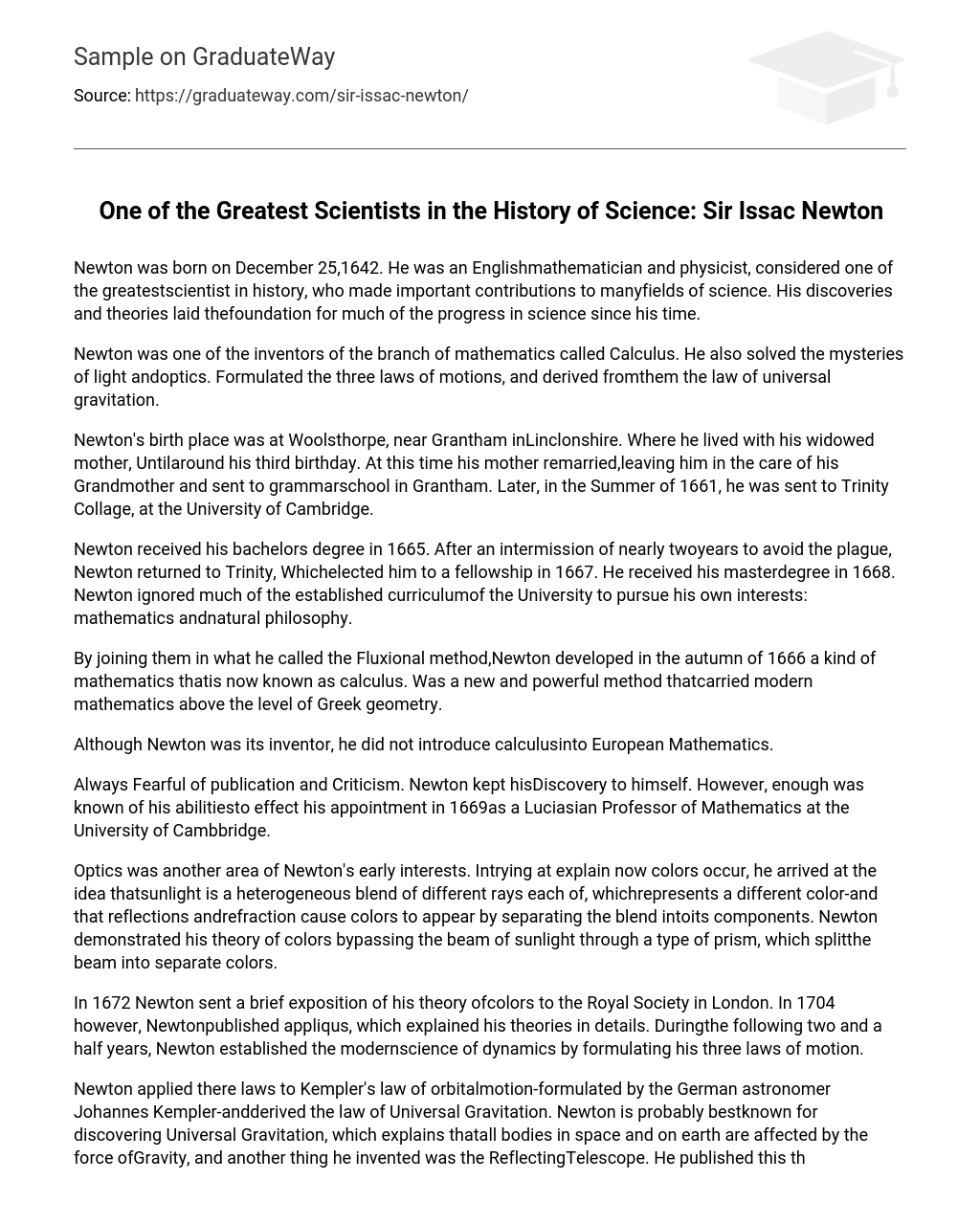Newton was born on December 25,1642. He was an Englishmathematician and physicist, considered one of the greatestscientist in history, who made important contributions to manyfields of science. His discoveries and theories laid thefoundation for much of the progress in science since his time.
Newton was one of the inventors of the branch of mathematics called Calculus. He also solved the mysteries of light andoptics. Formulated the three laws of motions, and derived fromthem the law of universal gravitation.
Newton’s birth place was at Woolsthorpe, near Grantham inLinclonshire. Where he lived with his widowed mother, Untilaround his third birthday. At this time his mother remarried,leaving him in the care of his Grandmother and sent to grammarschool in Grantham. Later, in the Summer of 1661, he was sent to Trinity Collage, at the University of Cambridge.
Newton received his bachelors degree in 1665. After an intermission of nearly twoyears to avoid the plague, Newton returned to Trinity, Whichelected him to a fellowship in 1667. He received his masterdegree in 1668. Newton ignored much of the established curriculumof the University to pursue his own interests: mathematics andnatural philosophy.
By joining them in what he called the Fluxional method,Newton developed in the autumn of 1666 a kind of mathematics thatis now known as calculus. Was a new and powerful method thatcarried modern mathematics above the level of Greek geometry.
Although Newton was its inventor, he did not introduce calculusinto European Mathematics.
Always Fearful of publication and Criticism. Newton kept hisDiscovery to himself. However, enough was known of his abilitiesto effect his appointment in 1669as a Luciasian Professor of Mathematics at the University of Cambbridge.
Optics was another area of Newton’s early interests. Intrying at explain now colors occur, he arrived at the idea thatsunlight is a heterogeneous blend of different rays each of, whichrepresents a different color-and that reflections andrefraction cause colors to appear by separating the blend intoits components. Newton demonstrated his theory of colors bypassing the beam of sunlight through a type of prism, which splitthe beam into separate colors.
In 1672 Newton sent a brief exposition of his theory ofcolors to the Royal Society in London. In 1704 however, Newtonpublished appliqus, which explained his theories in details. Duringthe following two and a half years, Newton established the modernscience of dynamics by formulating his three laws of motion.
Newton applied there laws to Kempler’s law of orbitalmotion-formulated by the German astronomer Johannes Kempler-andderived the law of Universal Gravitation. Newton is probably bestknown for discovering Universal Gravitation, which explains thatall bodies in space and on earth are affected by the force ofGravity, and another thing he invented was the ReflectingTelescope. He published this theory in his book PhilosophiaeNatural is Principia Mathematica in 1687. This book marked aturning point in the history of science; it also ensured that itsauthor could never regain his privacy.
In the same year, 1687, Newton helped lead Cambridge’s resistance to the efforts of King James II to make the Universitya Catholic institution, After the English Revolution in 1688,which drove James from England, the University elected Newton oneof its representatives in a special convening of the county’sParliament.
In the summer of 1693 Newton showed symptoms of a severeemotional disorder. Although he regained his health, his creativeperiod had come to an end. Newton’s connections with the leadersof the new regime in England led to his appointment as warden.
And later master of Royal Mint in London, where he lived after1696. In 1703 the Royal Society elected him President, an officehe held for the rest of his life. As President, he ordered theimmediate Publication of the Astronomical Observations of theFirst Astronomer Royal of England, John Flamsteed. Newton neededthese observations to perfect his Lunar theory.
Newton also compiled the book of evidence that the society published. The effects of the quarrel lingered nearly until hisdeath in 1727.
In addition to science, Newton also showed an interest inAlchemy, Mysticism, and Theology. Many pages of his notes andwriting-particularly from the later years of his career aredevoted to these topics. However, historians have found littleconnection between these interests and Newton’s scientific works.
Biographies





